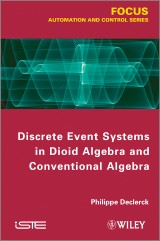Details

Discrete Event Systems in Dioid Algebra and Conventional Algebra
1. Aufl.
|
139,99 € |
|
| Verlag: | Wiley |
| Format: | |
| Veröffentl.: | 13.02.2013 |
| ISBN/EAN: | 9781118579657 |
| Sprache: | englisch |
| Anzahl Seiten: | 164 |
DRM-geschütztes eBook, Sie benötigen z.B. Adobe Digital Editions und eine Adobe ID zum Lesen.
Beschreibungen
<p>This book concerns the use of dioid algebra as (max, +) algebra to treat the synchronization of tasks expressed by the maximum of the ends of the tasks conditioning the beginning of another task – a criterion of linear programming. A classical example is the departure time of a train which should wait for the arrival of other trains in order to allow for the changeover of passengers.<br /> The content focuses on the modeling of a class of dynamic systems usually called “discrete event systems” where the timing of the events is crucial. Events are viewed as sudden changes in a process which is, essentially, a man-made system, such as automated manufacturing lines or transportation systems. Its main advantage is its formalism which allows us to clearly describe complex notions and the possibilities to transpose theoretical results between dioids and practical applications.</p>
<p><b>Chapter 1 Introduction 1</b></p> <p>1.1 General introduction 1</p> <p>1.2 History and three mainstays 2</p> <p>1.3 Scientific context 2</p> <p>1.3.1 Dioids 3</p> <p>1.3.2 Petri nets 4</p> <p>1.3.3 Time and algebraic models 5</p> <p>1.4 Organization of the book 7</p> <p><b>Chapter 2 Consistency 9</b></p> <p>2.1 Introduction 9</p> <p>2.1.1 Models 9</p> <p>2.1.2 Physical point of view 11</p> <p>2.1.3 Objectives 12</p> <p>2.2 Preliminaries 14</p> <p>2.3 Models and principle of the approach 17</p> <p>2.3.1 P-time event graphs 17</p> <p>2.3.2 Dater form 21</p> <p>2.3.3 Principle of the approach (example 2) 23</p> <p>2.4 Analysis in the “static” case 25</p> <p>2.5 “Dynamic” model 28</p> <p>2.6 Extremal acceptable trajectories by series of matrices 31</p> <p>2.6.1 Lowest state trajectory 32</p> <p>2.6.2 Greatest state trajectory 35</p> <p>2.7 Consistency 36</p> <p>2.7.1 Example 3 41</p> <p>2.7.2 Maximal horizon of temporal consistency 44</p> <p>2.7.3 Date of the first token deaths 47</p> <p>2.7.4 Computational complexity 48</p> <p>2.8 Conclusion 50</p> <p><b>Chapter 3 Cycle Time 53</b></p> <p>3.1 Objectives 53</p> <p>3.2 Problem without optimization 55</p> <p>3.2.1 Objective 55</p> <p>3.2.2 Matrix expression of a P-time event graph 56</p> <p>3.2.3 Matrix expression of P-time event graphs with interdependent residence durations 57</p> <p>3.2.4 General form Ax ≤ b 59</p> <p>3.2.5 Example 60</p> <p>3.2.6 Existence of a 1-periodic behavior 61</p> <p>3.2.7 Example continued 65</p> <p>3.3 Optimization 67</p> <p>3.3.1 Approach 1 67</p> <p>3.3.2 Example continued 69</p> <p>3.3.3 Approach 2 70</p> <p>3.4 Conclusion 75</p> <p>3.5 Appendix 76</p> <p><b>Chapter 4 Control with Specifications 79</b></p> <p>4.1 Introduction 79</p> <p>4.2 Time interval systems 80</p> <p>4.2.1 (min, max, +) algebraic models 81</p> <p>4.2.2 Timed event graphs 82</p> <p>4.2.3 P-time event graphs 83</p> <p>4.2.4 Time stream event graphs 84</p> <p>4.3 Control synthesis 88</p> <p>4.3.1 Problem 88</p> <p>4.3.2 Pedagogical example: education system 89</p> <p>4.3.3 Algebraic models 91</p> <p>4.4 Fixed-point approach 92</p> <p>4.4.1 Fixed-point formulation 92</p> <p>4.4.2 Existence 95</p> <p>4.4.3 Structure 103</p> <p>4.5 Algorithm 107</p> <p>4.6 Example 111</p> <p>4.6.1 Models 111</p> <p>4.6.2 Fixed-point formulation 113</p> <p>4.6.3 Existence 114</p> <p>4.6.4 Optimal control with specifications 116</p> <p>4.6.5 Initial conditions 117</p> <p>4.7 Conclusion 118</p> <p><b>Chapter 5 Online Aspect of Predictive Control 119</b></p> <p>5.1 Introduction 119</p> <p>5.1.1 Problem 119</p> <p>5.1.2 Specific characteristics 120</p> <p>5.2 Control without desired output (problem 1) 122</p> <p>5.2.1 Objective 122</p> <p>5.2.2 Example 1 123</p> <p>5.2.3 Trajectory description 124</p> <p>5.2.4 Relaxed system 125</p> <p>5.3 Control with desired output (problem 2) 127</p> <p>5.3.1 Objective 127</p> <p>5.3.2 Fixed-point form 128</p> <p>5.3.3 Relaxed system 129</p> <p>5.4 Control on a sliding horizon (problem 3): online and offline aspects 130</p> <p>5.4.1 CPU time of the online control 131</p> <p>5.5 Kleene star of the block tri-diagonal matrix and formal expressions of the sub-matrices 132</p> <p>5.6 Conclusion 138</p> <p>Bibliography 141</p> <p>List of Symbols 149</p> <p>Index 153</p>
<p><b>Philippe Declerck</b> is Senior Lecturer LISA / ISTIA Laboratory at University of Angers, France.</p>

















